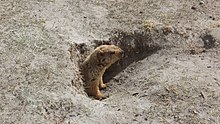Himalayan marmot
| Himalayan marmot | |
|---|---|

| |

| |
| Individual at Tshophu Lake, Bhutan (above), group with worn pelage in Ladakh, India (below) | |
| Scientific classification | |
| Domain: | Eukaryota |
| Kingdom: | Animalia |
| Phylum: | Chordata |
| Class: | Mammalia |
| Order: | Rodentia |
| Family: | Sciuridae |
| Genus: | Marmota |
| Species: | M. himalayana
|
| Binomial name | |
| Marmota himalayana (Hodgson, 1841)
| |
The Himalayan marmot (Marmota himalayana) is a
Taxonomy
Arctomys Himalayanus was the
The Himalayan marmot is very closely related to the
Characteristics

The Himalayan marmot has a dense woolly fur that is rufous grey on the back and rufous yellowish on ears, belly and limbs. The bridge of its nose and end of tail is dark brown.
Distribution and habitat
The Himalayan marmot occurs in the
Ecology and behaviour

The Himalayan marmot lives in
Reproduction
Females become sexually mature at the age of two years. After one month of gestation they give birth to litters of two to 11 young.[7]
Predators
On the
In culture
It was known to the ancient Greek writers as the gold-digging ant apparently as reference to the fact that gold nuggets were found in the silts of the burrows these marmots dug.[12][13] The French ethnologist Michel Peissel claimed that the story of 'gold-digging ants' reported by the Greek historian Herodotus was founded on the golden Himalayan marmot of the Deosai plateau and the habit of local tribes such as the Minaro to collect the gold dust excavated from their burrows.[14]
A photograph of a Himalayan marmot under attack by a Tibetan fox taken by Bao Yongqing won the overall prize in the 2019 Wildlife Photographer of the Year award.[15]
See also
References
- ^ a b Shrestha, T. (2017) [errata version of 2016 assessment]. "Marmota himalayana". IUCN Red List of Threatened Species. 2016: e.T12826A115106426.
- ^ a b Hodgson, B. H. (1841). "Notice of the Marmot of the Himalaya and of Tibet". The Journal of the Asiatic Society of Bengal. 10 (2): 777–778.
- OCLC 62265494.
- ^ a b c d Kryštufek, B.; Vohralík, B. (2013). "Taxonomic revision of the Palaearctic rodents (Rodentia). Part 2. Sciuridae: Urocitellus, Marmota and Sciurotamias". Lynx, N. S. (Praha). 44: 27–138.
- ^ S2CID 23526958.
- .
- ^ a b c Molur, S.; Srinivasulu, C.; Srinivasulu, B.; Walker, S.; Nameer, P.O.; Ravikumar, L. (2005). Status of non-volant small mammals: Conservation Assessment and Management Plan (C.A.M.P) workshop report. Coimbatore, India: Zoo Outreach Organisation / CBSG-South Asia.
- ^ Smith, A.T.; Xie, Y. (2008). A Guide to the Mammals of China. Princeton, New Jersey: Princeton University Press.
- PMID 24533080.
- ^ Padgett, L.; Small, C. (2011). "Marmota himalayana, Himalayan marmot". Animal Diversity Web. Archived from the original on 6 September 2019. Retrieved 2 August 2020.
- ^ Rajat Ghai (7 July 2020). "After bats, do not make marmots into villains: Expert". Down To Earth. Archived from the original on 2 August 2020. Retrieved 2 August 2020.
- New York Times. Archived from the originalon 2016-04-14 – via livius.org.
- ^ N. Shiva Kumar (September 22, 2013). "Marmots caught off guard". The Hindu. Archived from the original on November 29, 2014. Retrieved May 7, 2016.
- ISBN 978-0-00-272514-9.
- ^ "Wildlife photographer of the year 2019 winners – in pictures". The Guardian. 2019-10-16. Archived from the original on 2019-10-16. Retrieved 16 October 2019.

